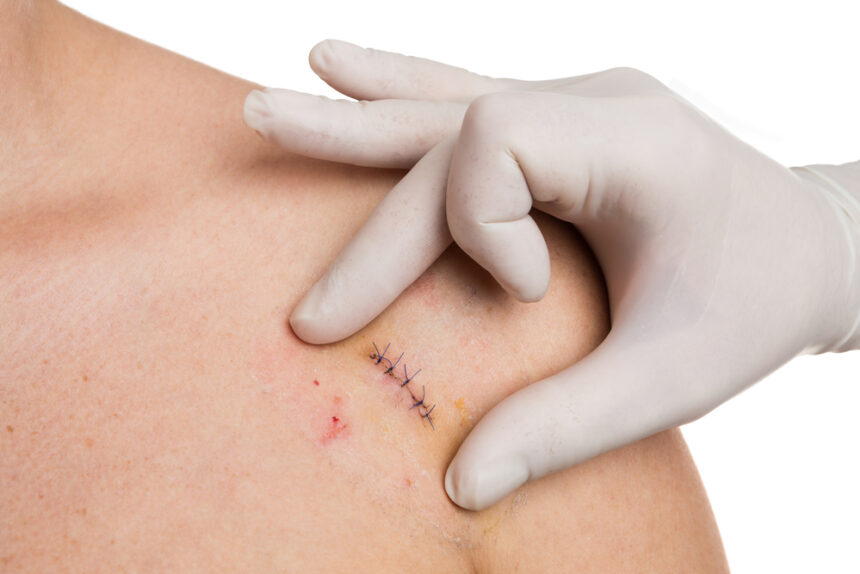Mohs surgeons are dermatologists who have completed extensive additional training in the specialized surgical technique of micrographic surgery. This procedure is designed for the removal of skin cancer. A Mohs procedure focuses on the surgical removal of cancerous tissue and its subsequent pathological examination. This allows the surgeon to serve as both surgeon and pathologist during the procedure. Here’s more information on Mohs Surgery:
What Happens During Mohs Surgery?
The Mohs surgery process is methodical and precise, typically performed in an outpatient setting using local anesthesia. Mohs surgeons identify the visible portion of the skin cancer and begin by removing it. Next, a very thin layer of tissue is removed from the treatment site.
This initial thin layer is carefully mapped and color-coded to maintain its exact orientation to the patient’s body. While the patient waits, the removed tissue is processed in an on-site laboratory. The surgeon then examines it under a microscope to check for cancer cells at the margins.
If any cancer cells are found, their exact location is marked on the map. The surgeon then returns to the patient and removes another thin layer of tissue only from the specific area where cancer cells were detected. This cycle of removal and microscopic examination is repeated until no more cancer cells are found, signifying that the entire tumor has been removed.
What Cancers Are Treated With Mohs Surgery?
Mohs surgery is most commonly used to treat the two most prevalent types of skin cancer: basal cell carcinoma (BCC) and squamous cell carcinoma (SCC). Mohs is a primary treatment option for preserving healthy tissue, especially for areas like the face, hands, feet, and neck. The procedure is also indicated for BCCs or SCCs that are large, have recurred after previous treatment, or have indistinct borders.
In certain situations, Mohs surgery may be used for other, less common types of skin cancer. A consultation with a qualified surgeon can determine if this approach is suitable for an individual’s specific diagnosis. While Mohs surgery is highly effective for BCC and SCC, be aware of all forms of skin cancer, including melanoma. Melanomas have specific warning signs, often remembered by the ABCDEs guide:
- Asymmetry
- Border
- Color
- Diameter
- Evolving
Risks for developing melanoma include extensive sun exposure, a history of blistering sunburns, fair skin, and a family or personal history of the disease. Regular skin self-examinations and professional dermatologic check-ups are key for early detection.
Why Is Mohs Surgery Effective?
The effectiveness of Mohs surgery lies in its systematic, microscopic examination of 100% of the surgical margin. Mohs micrographic techniques completely remove cancer while sparing as much healthy surrounding tissue as possible. This level of precision leads to higher cure rates and minimizes scarring.
Excision Techniques
While Mohs surgery and traditional excision procedures both aim to remove cancerous tissue, they differ significantly in technique and precision. Traditional excision involves removing the visible tumor along with a predetermined margin of surrounding tissue, which is then sent to a lab for evaluation. The excision process may take several days, and there’s a chance that residual cancerous cells could remain, requiring additional surgeries.
Mohs Techniques
Mohs surgery is a step-by-step procedure performed in real time. The surgeon systematically removes thin layers of tissue and examines each layer under a microscope on-site to check for cancer cells. This meticulous process continues until no cancer remains, removing the complete tumor while sparing as much healthy tissue as possible. A Mohs approach results in reduced need for additional treatments and improved cosmetic outcomes compared to traditional excision.
Learn More About Mohs Surgeons
Mohs surgeons undergo specialized fellowship training after their dermatology residency to master this detailed procedure. Advanced training equips surgeons with the necessary skills to perform the surgery and accurately interpret tissue samples. If you have been diagnosed with skin cancer, a discussion with a dermatologist can help you understand all available treatment options. Contact a dermatologist today to learn more.









